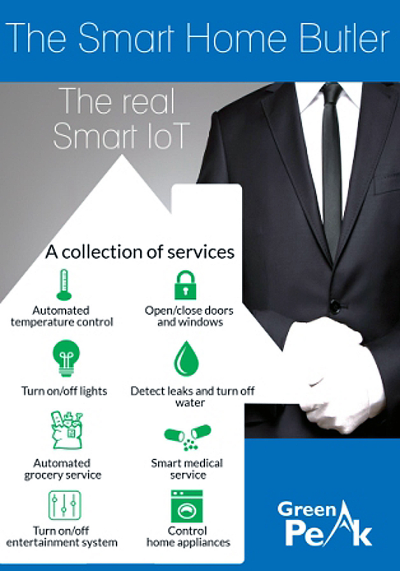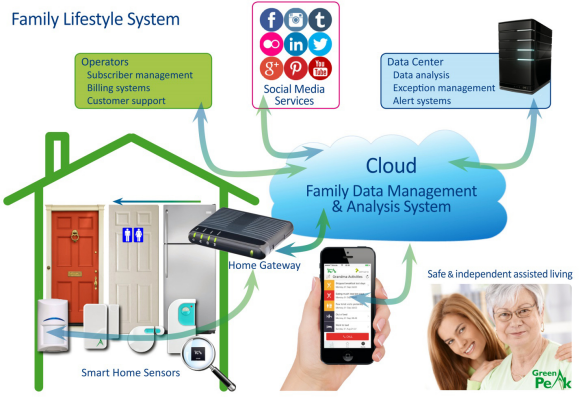
Many in the sensor industry are wondering why consumers are not jumping on the Smart Home bandwagon. Despite the many predictions of a totally automated home within a few years, the end users are not clamoring for Smart Homes? Why?
There are a couple of reasons. One is that the companies that actually design, develop and manufacture sensor and smart devices are confused by the ever changing and conflicting status of Smart Home and IoT connectivity standards. A couple years ago, it was simple. Wi-Fi was for networking devices with AC power, Bluetooth was for devices that were wearable, for replacing cables or for connecting smart phones, and ZigBee was for networking low power, low data rate for sensor devices that ran on batteries. However, over the last couple of years, the market has gotten very complicated for device developers.
Numerous large companies have developed their own connectivity "standards" that they have decided should be the standard for the Smart Home. In addition, various consortiums and industry groups have emerged saying the same thing, that their technology is the connectivity technology that should be the base for all Smart Home industry. This pits Apple against Intel and its friends against Qualcomm and its friends against Google and its ecosystem. All of them are now battling against Wi-Fi, ZigBee and Bluetooth.
All of the platforms and standards basically do the same thing. They connect sentrollers, which are sensor devices, controllers and actuators, to each other and the internet. Each of these groups are battling with millions of dollars of marketing money to be THE ONE. No wonder sensor and device makers don't know which way to go.
The second reason the market is slow to develop is that the consumers don't really want things, they want solutions. Aside from the so-called early innovators and DIYers, most people don't want to fuss with a Smart Home system. They don't want to have to research the various sensors, hubs, cloud intelligence options, connectivity standards, etc. They don't want to figure out how and where to install the sensors. They don't want to go through the pain of manually configuring the devices and make them to connect to their internet gateways to get access over the web.
They simply want to turn it on and have it work. They want a service that they can use to automate and to manage their home, their security, and their environment. Instead of being a do it yourself project, this solution would be marketed, installed, and managed by the companies that already deliver digital and connectivity services to the home, i.e., the various telecom, internet service, and cable companies.
Next page
The Smart Home Butler
What do you see when you visualize a butler? Someone who works in your house and helps make your life easier, more comfortable, and maybe even safer? Butlers do not need to be taught how to open the door when someone knocks, you don't need to teach them to adjust the thermostat if the house is too hot or two cold. You don't need to teach a butler how to respond if a criminal tries to break in or if your teenagers decide to throw a party while you are gone on vacation.
In the same way, a "Smart Home Butler" is smart. You don't need to teach it everything. Not only does it already know how to do certain things, but just like a human butler, the Smart Home Butler can learn what is normal for a specific household and then can adjust the home's systems to ensure normalcy.

Fig. 1: The "Smart Home Butler" learns how a household operates and provides the intelligence and responsiveness needed to ensure the resident's peace of mind.
By using a variety of sensors located throughout the home – motion sensors, temperature sensors, presence sensors, etc., the house can learn how the family lives and their daily schedule. The sensors talk to a central Smart Home gateway which then uses intelligence to learn what is happening in the home over a period of time. If something out of the ordinary occurs, it can react and send an appropriate alert. For instance, at 2 in the afternoon, when everyone should be at school or at work, it notices a door opening, it can send a message to the homeowner and ask if it should alert the neighbors or police.
Next page
This intelligence is driven by a self-learning algorithm in the cloud where it can use accumulated intelligence from hundreds, thousands or millions of other households, to learn what is normal and what is not.

Fig. 2: Managed by operators, the family lifestyle system combines Smart Home sensors, data centers, wireless connectivity, analytics algorithm and cloud intelligence to make people's lives safer, more effective and more comfortable.
For instance, in a certain town, the intelligent Smart Home Butler learns that when rain clouds appear and humidity levels go up, that most households in that town close their windows and turn on the heaters. The Smart Home Butler can then do that as well without having to rely on a human to teach them or program them to do that.
This is yet another reason to use an internet service provider to run the system. Instead of relying on individual households to program their homes, the cloud intelligence can use a much wider sphere of input to make decisions. The more input the Smart Home Butler application can digest and consider, the smarter its reactions and alerts will be.
Modern Day Cars are Essentially a Smart Service
Compare the typical modern automobile with the typical modern home. Cars are so much smarter and so much better engineered. They require a lot less guidance and knowledge to operate than does a home.
For example, press one button in your car and all your windows close. Press another button inside your car and all the doors lock. It sounds very simple but very few homes can offer that convenience. Decades ago, people actually knew how their car's various systems operated. Nowadays, the car's engine, transmission and other systems are so smart, so reliable, that most of us have little or no idea how it all works. As long as our cars start and get us to our destinations safely, we are happy. When was the last time you physically checked the oil levels in your car?
Compare that to our homes. If you want your home to be comfortable, you get up off your couch and adjust the AC or the heating. If you want your home to be secure, you walk around and check all the doors, windows and locks. The car's seat belt system knows who is sitting where and makes sure that all the seat belts are correctly fastened. How come there is no indicator in the home to ensure safety or at least tell us where the people are?
Next page
Why aren't our homes as smart as our cars? Yes, we can install after-market systems in our homes that will provide us with many of the same features as we already have in our cars but it is a hassle. We have to shop for the right sensor, we have to make sure that these sensors will talk to each other, we need to figure out how they will be controlled and then we need to program them so that our home will function the way we like. Can you imagine if you had to program your car's steering wheel to aim the car in the right direction, to program the brakes to stop the car when you hit the brake pedal? That is essentially where we are now with the so-called Smart Home.
Bottom Line
Consumers do not want to do all that work. They don't want to have to get an engineering degree to make their homes smart. They say that they do want an automated home, they do want Smart Home benefits and features, but they don't want to do it themselves.
This is the big opportunity for the service providers and operators who already have a connection into the home. They already have an ongoing installation, management, maintenance, and billing relationship. By shifting the responsibility for the Smart Home – its sensors, actuators and intelligence away from individual consumers and DIYers, and instead to the service experts, the industry will be able to give a big kick start to the actual sensor and device manufacturers who want to leverage the potential of the emerging Smart Home market.
Here is the lesson of success for Smart Home sensor manufacturers and device manufacturers. Don't sell devices to consumers. Instead, market your devices to the service providers and let them do the consumer education.
About the Author
Cees Links is the founder and CEO of GreenPeak. Under his responsibility, the first wireless LANs (WLANs) were developed, ultimately becoming household technology integrated into PCs and notebooks. He also pioneered the development of access points, home networking routers, and hotspot base-stations. He was involved in the establishment of the IEEE 802.11 standardization committee and the Wi-Fi Alliance. And, he was instrumental in establishing the IEEE 802.15 standardization committee to become the basis for the ZigBee sense and control networking. For more information, please visit the Green Peak website at http://www.greenpeak.com.
Related Stories
Half of Americans Will Have Smart-Home Tech by End of 2016
Wi-Fi Alliance Introduces Wi-Fi HaLow Tech for Internet of Things
NanoSense Offers Total Home Control with the Tap of a Finger